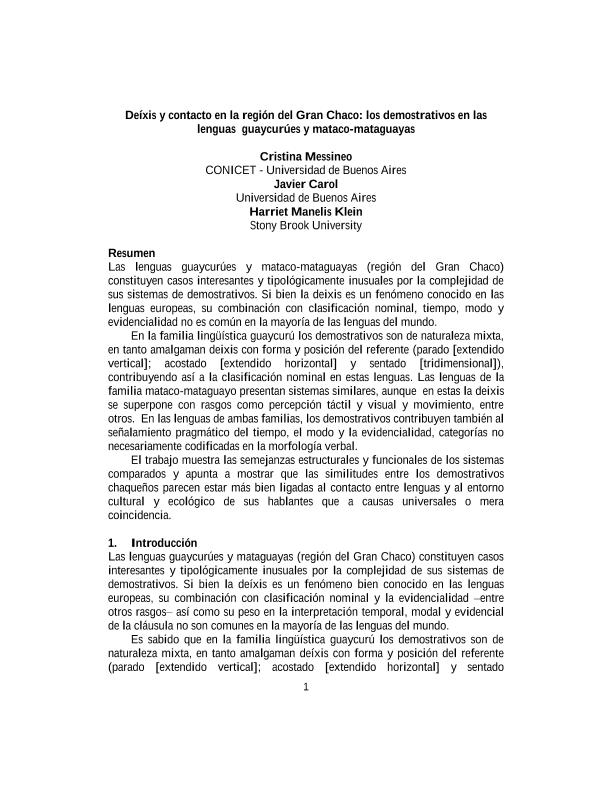Artículo
International Journal of the Sociology of Language | Volume 2016: Issue 240 Deíxis y contacto en la región del Gran Chaco: Los demostrativos en las lenguas guaycurúes y mataguayas Cristina Messineo , Javier Carol and Harriet E. Manelis Klein DOI: https://doi.org/10.1515/ijsl-2016-0017 | Published online: 04 May 2016 ABSTRACT REFERENCES RECOMMENDATIONS Resumen Las lenguas guaycurúes y mataguayas (Gran Chaco) constituyen casos interesantes y tipológicamente inusuales por la complejidad de sus sistemas de demostrativos que combinan deíxis espacial con rasgos como visibilidad, tangibilidad, movimiento, postura y evidencia (visual). Sistemas similares han sido hallados en otras lenguas del mundo, aunque la combinación de estos con postura y/o movimiento es atípica. En la familia guaycurú los demostrativos, además de cumplir la función de determinantes, son clasificadores nominales. Esta característica, en cambio, no es del todo compartida por las lenguas mataguayas. En las lenguas de ambas familias los demostrativos contribuyen también al señalamiento pragmático del tiempo, el modo y la evidencialidad, no necesariamente codificados en el predicado. El trabajo muestra las semejanzas entre los sistemas de ambas familias y propone que ellas no pueden explicarse por causas universales o mera coincidencia, sino que el contacto juega allí un papel importante. Por otra parte, aun cuando la hipótesis de una relación genética entre ambas familias sea razonable, esta no parece suficiente para explicar las similitudes en los sistemas de demostrativos, que van más allá de las formas presumiblemente cognadas. Guaykuruan and Mataguayan languages (Gran Chaco) are typologically interesting and unusual cases due to the complexity of their demonstrative systems, which combine spatial deixis with features such as visibility, tangibility, motion, position and (visual) evidence. Similar systems have been found in other languages of the world, although the combination of those with position and/or motion is atypical. In the Guaykuruan family the demonstratives, in addition to having the role of determiners, are nominal classifiers. This feature, however, is not entirely shared with the Mataguayan languages. In the languages of both families demonstratives also contribute to the pragmatic signalling of tense, mood and evidentiality, which are not necessarily encoded in the predicate. This article shows the similarities between the systems of both families and proposes that they cannot be explained by universal causes or mere coincidence, but rather that contact plays an important role here. Moreover, even if the hypothesis of a genetic relationship between the two families is reasonable, this does not seem to be sufficient to explain the similarities in the demonstrative systems, which surpass the presumably cognate forms.
Deíxis y contacto en la región del Gran Chaco: los demostrativos en las lenguas guaycurúes y mataco-mataguayas
Título:
Deixis and contact in the region of Gran Chaco: Demonstrative systems in Guaykuruan and Mataguayan languages
Fecha de publicación:
07/2016
Editorial:
De Gruyter
Revista:
International Journal of the Sociology of Language
ISSN:
0165-2516
e-ISSN:
1613-3668
Idioma:
Español
Tipo de recurso:
Artículo publicado
Clasificación temática:
Resumen
Archivos asociados
Licencia
Identificadores
Colecciones
Articulos(SEDE CENTRAL)
Articulos de SEDE CENTRAL
Articulos de SEDE CENTRAL
Citación
Messineo, Maria Cristina; Carol, Javier Jerónimo; Klein, Harriet Manelis; Deíxis y contacto en la región del Gran Chaco: los demostrativos en las lenguas guaycurúes y mataco-mataguayas; De Gruyter; International Journal of the Sociology of Language; 2016; 240; 7-2016; 119-157
Compartir
Altmétricas




